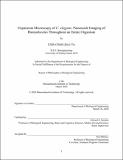Expansion microscopy of C. elegans : nanoscale imaging of biomolecules throughout an entire organism
Author(s)
Yu, Chih-Chieh (Chih-Chieh Jay)
Download1242031694-MIT.pdf (27.95Mb)
Other Contributors
Massachusetts Institute of Technology. Department of Biological Engineering.
Terms of use
Metadata
Show full item recordAbstract
Expansion microscopy (ExM) enables 3-D, nanoscale-precise imaging of biological specimens by isotropic swelling of hydrogel-embedded, chemically processed tissue. Such capability raises the question of whether nanoscale mapping of biomolecules could be performed in an entire organism, which would allow super-resolution-mediated in situ analyses, such as digital quantification of biomolecules and mapping of synaptic contacts, to be performed within the context of an entire nervous system. The nematode Caenorhabditis elegans could be a suitable model for such organism-wide analyses, due to its tractable physical size, deterministic cell lineage, ease of genetic control, and well-established literature. However, C. elegans is enclosed in a chemically impermeable and mechanically tough cuticle, which could hinder the deployment of ExM. In this thesis, we present a strategy, expansion of C. elegans (ExCel), to expand fixed, cuticle-enclosed intact animals of C. elegans. ExCel enables simultaneous readout of fluorescent proteins, RNAs, DNA locations, and anatomical structures at resolutions of ~65-75 nm (3.3-3.8x linear expansion). We also developed epitope-preserving ExCel, which enables imaging of endogenous proteins stained by antibodies, and iterative ExCel, which enables imaging of fluorescent proteins at a ~25-nm resolution (20x linear expansion). We demonstrate the utility of the ExCel toolbox for multiplexed imaging of multiple molecular types, for mapping synaptic proteins, for identifying previously unreported proteins at cell junctions, and for gene expression analysis in multiple individual neurons of the same animal. In addition to ExCel, we discuss two other ExM-related technologies, including tetragel, which is a highly homogeneous hydrogel network that improves the nanoscale isotropy of biological ultrastructure expanded by ExM, and stochastic arrangement of reporters in clusters (STARC), which is a strategy for recording neuronal activity at a subneurite-level resolution, in densely labeled neuronal populations. Taken together, the work presented in this thesis extends the capabilities of ExM, and lays the foundation for a comprehensive, functionally and structurally informed analysis of an entire organism, which could reveal new insights in neuroscience, organismal development, and systems biology.
Description
Thesis: Ph. D., Massachusetts Institute of Technology, Department of Biological Engineering, May, 2020 Cataloged from student-submitted PDF version of thesis. "March 2020." Date of graduation, May 2020. Includes bibliographical references (pages 140-146).
Date issued
2020Department
Massachusetts Institute of Technology. Department of Biological EngineeringPublisher
Massachusetts Institute of Technology
Keywords
Biological Engineering.